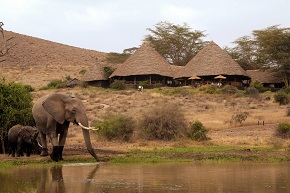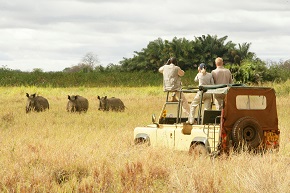This year I was happy to be invited by Cheli & Peacock to visit their property portfolio in Kenya, an opportunity I jumped at being a part of.
Cheli & Peacock is owned and operated by Stefano Cheli and Liz Peacock, former safari guides who dreamed of creating a business through which they could share their authentic safari experiences with others. The company was formed in 1985, with their first property, Tortilis Camp in Amboseli, built in 1994. Today the company boasts some of the most diverse, eco-friendly, remote and luxurious properties in Kenya. There was one lodge in particular though, that I was looking forward to seeing; Elsa's Kopje, found in the Meru National Park.

Attached to this lodge is one of the most incredible success stories for conservation and tourism alike. Poaching has always been a huge issue for the Meru National Park, so much so that by the late 1980s very little if any large game remained, with elephant numbers greatly in decline and the rhino population wiped out entirely. With such limited wildlife remaining and the severe drop in tourism, the Kenyan government was on the verge of de-proclaiming the park in 1989. It was at this point Stefano and Liz Cheli fought to secure Merus future existence. After four long years of negotiations with the Kenya Wildlife Service (KWS) the efforts of Stefano and Liz finally paid off and the parks status remained.
Although this was a great victory, the parks status continued to be in jeopardy throughout 1994 as long as visitor numbers remained low. It would take a further six years of conservation work in Meru National Park before Stefano and Liz could finally open Elsas Kopje, a lodge they hoped would create the influx of tourists the park needed to survive.

Since the lodge opened in 1999, Meru National Park experienced a steady increase in visitor numbers, from 3,500 in 1999 to 15,200 in 2009 and now has a reputation as one of the best wilderness areas on the safari circuit. Elsas Kopje contributed $150,479 to the KWS in 2011 alone through lease payments and park fees. The generation of these funds has triggered restorative action by the KWS and new infrastructure and security networks have been implemented. These include a 24 hour rhino surveillance service, introduced in 2003 and a specialised poaching intelligence unit, with has proved incredibly effective.

At least 1,350 animals have been successfully translocated to Meru, including reticulated giraffe, Grevys zebra, impala, Bohors reedbuck, leopard and elephant. The rich diversity also includes more than 400 bird species. KWS has also installed a 20,750 acre rhino sanctuary which now protects a population of over 70 white and black rhino. All this considered, Elsas Kopje has undoubtedly made a huge contribution to ensuring that Meru National Park is once again a viable conservation area. Along with Elsas Kopje Cheli & Peacock have gone to great lengths to carry through unimaginably high conservation efforts throughout their entire property portfolio, their conservation efforts truly are tied into the success of their lodges and as such I find the company a true inspiration.

